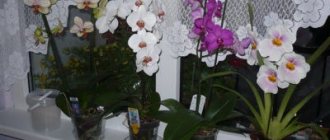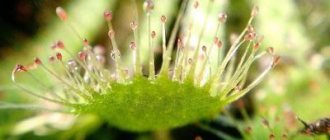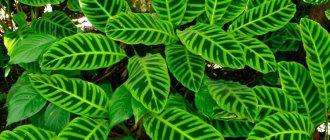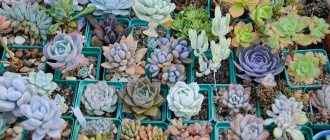Native to the tropical regions of southeast Asia, aglaonemas are evergreen plants that are both very unpretentious and attractive.
The species discovered and described at the end of the century before last were exported to Europe, where aglaonema plants began to be successfully grown in greenhouses. By this time, Europeans had domesticated many different exotic plants that captured the imagination with their bright blooms or unusual appearance. The richness of tropical flora has invariably aroused the interest of botanists and gardeners, but what attracted them to Aglaonema?
What does aglaonema look like?
The flower's appearance resembles a small bush 0.25-1 m high with a short straight stem and tightly fitting long fleshy leaves. They can be different shades of green and, less often, red (depending on the variety), with white, pink, silver, yellow streaks and spots. The green pet blooms with small cobs, which are strewn with pale green, pink or white small rosettes. The fruits are ruby or orange oblong berries, sometimes white, with one seed inside, suitable for sowing.
Varieties of Aglaonema
Due to the height of the bushes, flower varieties are divided into three groups:
- Short. They have a size of up to 25 cm, creeping or drooping stems;
- Medium height. Their leaf blades grow up to 30 cm in length;
- Tall. They have a size of 1 m and leaves up to 40 cm.
The most famous types of aglaonema with photos:
- "Silver Queen" A flower up to 40 cm high that loves a lot of light, which gives it a special variegation. It has a beautiful silver-blue leaf surface;
- “Crete” (sometimes called red aglaonema) is a plant with brightly colored foliage with pinkish, green, and purple splashes. The variety requires bright lighting. Reaches 30-40 cm in height;
- "Maria". It is a medium-sized crop with dense emerald-colored leaves. This “green resident” is shade-tolerant; even a room with artificial light will suit it;
- "Modest." The bright green plant reaches a height of 50 cm, has pointed leaves, rounded with noticeable veins, which are elongated up to 20 cm;
- “Changable” (another name is “changeable”). It is an upright bush with elongated dark green glossy foliage in the shape of an ellipse, up to 30 cm long. A room with diffused light is well suited for favorable growth.
Planting and growing a flower
It is not recommended to immediately replant a houseplant aglaonema purchased in a store. Let it adapt within 2-3 weeks.
Landing rules:
- Place drainage in the pot - expanded clay, small pebbles, broken shards or nut shells;
- Fill the soil up to 1/2 volume;
- Place the flower in the center of the pot, straighten the roots, add substrate;
- If the plant is young, then there is no need to deepen it, but an adult plant can be planted a little;
- Generously water the crop with warm water.
What can be done to make the flower grow lush and beautiful? You need to know its features:
- The tropical bush loves places with diffused light, as well as slightly shaded ones. Protect it from direct sunlight and do not place it near heating appliances;
- In summer, the temperature should be + 20-25 degrees, in winter – slightly lower;
- The flower prefers warmth and high humidity, so water it twice a week, and especially take this into account in dry weather;
- The culture does not tolerate drafts and does not like to come into contact with tobacco and other smoke.
Watering
Water the aglaonema with settled or boiled warm water, generously from spring to autumn, moderately in winter. Before watering, be sure to check whether the top layer of soil in the pot is dry. Aglaonema cannot tolerate stagnant water. Wet, non-drying soil in a pot at low air temperatures can affect the appearance of the plant and the condition of the root system - it will rot.
To determine whether a plant needs watering, simply tap the pot. If the soil in the pot is damp, the sound will be dull; the drier the soil, the louder the sound.
Soil and pot for the plant
In order for a flower to grow healthy and attractive, it is necessary to have nutritious soil. The soil should have good water and air permeability and be loose. If you prepare the soil yourself, then in composition it should consist of: three parts of leaf soil, one part of peat, one part of sand, as well as 1/2 part of charcoal and 1/2 part of humus. You can buy ready-made soil for heather, azaleas or violets. This composition is perfect for our “green friend”.
The root system of the plant is fibrous and superficial, so it does not need a deep pot. An indoor flower has excellent leaf growth and better development is possible if its roots grow in a small container. The ideal option would be a wide (if there are young shoots) and shallow pot, but do not forget that 1/4 of its height must be filled with drainage.
Rooting of apical shoots
Cut off the young tops, leaving a height of up to 10 cm, and place them on paper overnight to dry. There are two ways to root the tops:
- placing them in a container with settled water;
- immediately planted in a small pot with nutritious soil.
If the top is rooted in the soil, its leaves should be tied into a bunch to slow down the evaporation of moisture. In addition, it is necessary to provide the plant with greenhouse conditions - cover it with a cut-off bottle or place the flowerpot in a bag.
When the top takes root and begins to produce young shoots, the cover is removed and over time the plant is transferred to a permanent pot.
How to care for aglaonema
Caring for aglaonema at home involves regular watering, fertilizing, spraying and timely replanting. To maintain air humidity at the desired level around the pot, it can be placed in a tray with wet pebbles or expanded clay. The leaves of the plant must be frequently wiped or watered from the shower. Then they will not lose their shine and brightness. Let's look at the description of the rules of care in more detail.
Watering aglaonema
Abundant watering of the plant must be done from April to November, when the top layer of soil dries out. But moisture should not be allowed to remain in the root system for a long time. The frequency and abundance of watering is selected based on the temperature of the room - when it is cool, the flower requires less water.
In winter, the amount of moisture is reduced by watering two days after the soil has dried. In summer, it is necessary to water the bush every other day.
Pruning aglaonema
In order for a flower to become bushy, you need to prevent it from blooming and cut off growing shoots with buds. This will lead to the appearance of new buds, and the bush will begin to grow, acquire splendor and beauty.
If during growth the stems become bare and the shoot seems bald, then the top of the trunk on which the voids have appeared is cut off. Soon after this, young leaves and shoots will begin to grow at the cut site. And the cut cuttings can be placed in water or in soil covered with film. After some time it will begin to take root.
Biological description
The decorative effect of the plant is provided primarily by its leaves. They are quite wide and long. Some leaves may have interesting textured colors or structural features of the edges.
Aglaonema moderate in a driftwood pot
The variety of varieties and varieties of aglaonema allows the plant to be used in a wide variety of design solutions . This is an unpretentious and low-maintenance plant that even a person with very little botanical knowledge can handle.
Aglaonema is an evergreen herb or subshrub from the broad group of Araceae . Almost all Aroids are representatives of the Equatorial climate, however, our beauty comes from East Asia, more precisely from India. There are also wild species of Aglaonema in Malaysia and the Philippines.
In total, there are about 50 species of this plant , however, due to the commonality of some of its representatives, which have characteristic properties in common with other members of the family, some botanists accept the number of species as 23.
Such confusion in classification often leads to the fact that even within one relatively small subfamily, not every botanist can accurately differentiate one species or another. On the other hand, this is wonderful in its own way, since you can always say that you have a unique flower of the Araceae family, which no one else in the world has!
Young plants
A feature of the plant is the virtually complete absence of a stem. The stem serves solely to form and maintain the flower. There are no foliage on the stem; it grows from the root without the participation of the stem on its own. However, in adult representatives a certain semblance of a stem can form - a short part of the growing season that has a noticeable thickening, different from the leaves.
Growth is relatively slow. No more than 5-6 leaves may appear on a flower in a year. This low growth rate is explained by the living conditions of the flower. In its natural habitat, Aglaonema is on the lowest tier, and is content with the “remnants” of light that reach it from higher competitors.
The flowering parts are collected in inflorescences, which, like all Araceae, are cobs; The inflorescence contains up to 9 flowers. Ears are formed in the axils of the leaves; their number can reach up to three pieces per leaf. An interesting fact is the dioeciousness of the flower. That is, the plant has separate male and female flowers, which will have to be taken into account when artificially pollinating it.
Aglaonema ribbed flower
Aglaonema fruits ripen within six months, and their cultivation makes sense. Reason one: aglaonema is one of the few plants capable of normal seed propagation at home. Reason two: the fruits of aglaonema are more decorative and much more attractive than its flowers.
Each “berry” formed in the cob contains only one seed, but taking into account the total number of cobs and seeds in each inflorescence, the number of seeds obtained from one bush can be from 50 to 100 pieces.
Aglaonema, especially rich in leaves, is theoretically capable of producing up to 200 seeds . Seed germination is very high, so there are usually no problems with seed propagation.
Fruits of Aglaonema modified
Unlike the same spathiphyllum and zamioculcas, the aglaonema flower does not have any artistic value. This, in fact, is not critical, since the main part of the plant that attracts a person is not its flowers, but its leaves.
The leaf blades of Aglaonema have an ellipsoidal shape. Sometimes they are elongated and have pointed ends. At the beginning of their life, almost all the leaves of the plant are round, but then their shape changes. The veins on both young and adult leaves are practically indistinguishable against the general background of the leaf.
The size of the leaves may vary not only from species to species, but also within each of them. The length of the leaves can be from 10 to 60 cm. The color can vary from classic green to green with white or yellow spots. There are leaves that are completely white, as well as leaves with large areas of purple-red pigment.
Leaves of Aglaonema siamese, which has purple leaves
The height of the flower can reach up to 150 cm, however, the vast majority of flower growers prefer bushes of medium height. Part of the reason is that taller plants have more brittle leaves, especially at the base of the petioles.
Reproduction of aglaonema
This plant can be propagated in three ways:
- Dividing the bush;
- By cuttings;
- Seeds.
The first method is the easiest to implement. During the April or May transplantation, strong, healthy shoots with 3-4 leaves and roots are carefully plucked from the bush. In this case, the part that should be underground is carefully cut with a sharp knife. The daughter shoot is planted for rooting in a separate container with fertile soil. With regular watering and fertilization, it begins to grow vigorously.
The second method - cuttings, involves cutting the stem with the apical part and dividing the trunk into several more segments of 9-12 cm, each of which should have leaves. The cuttings are dried for a couple of days, the sections are covered with charcoal. Next comes the rooting stage:
- The cuttings are planted to a depth of 5 cm in a mixture of sand and peat;
- Rooting must be done at a temperature of +22-25 degrees. This will help the roots form faster within a month;
- By providing the flower with heating from below, rooting can be carried out at any time of the year. Otherwise, it is better to wait for warm summer time;
- After strengthening the bush, it can be moved to a separate container filled with soil for young plants.
Reproduction by seeds, which emerge from red fruits, is carried out in the summer. It is not worth storing seed material, because it quickly deteriorates and loses its viability.
- Aglaonema seeds are washed and immediately sown in cups with a sand-peat substrate;
- They need to be constantly watered and kept in a warm place;
- Shoots appear quite quickly. When forming leaves, you need to plant the flowers in separate pots;
- Full development of plants occurs after 3-4 years, but varietal characteristics are not always preserved.
You can buy an already mature aglaonema flower in flower shops or in specialized online stores. The cost varies significantly depending on the type. It starts from about 600 rubles and can reach up to 6,000 rubles. You can also purchase the plant from amateur florists, where the price will be significantly lower.
Such a bright tropical bush can serve as a decoration for any home, and its main advantage is its unpretentiousness, which is highly valued by floriculture lovers.
Stem cuttings
The bare shoots remaining after pruning the plant are an excellent material for the propagation of aglaonema, because they have many dormant buds. To stimulate awakening, it is necessary to cut the stem into cuttings 5 to 10 cm long. Next, they are placed to choose from:
- into a glass of water, giving the cuttings a vertical position;
- immediately into a pot with nutritious soil, laying the cutting down and sprinkling it with a little soil.
All cuts must be powdered with charcoal and allowed to dry.
At the same time, roots will form on the stem and young shoots will sprout. If you place the cuttings in the soil, young branches will sprout at the very base of the ground.
If there is a leaf on a piece of stem, rooting will be faster.
Stem cuttings rooted in water are planted in a nutrient substrate, one cutting in each pot, and placed on a windowsill with good but diffuse lighting. The first transshipment of young plants should be done no earlier than when the roots have entwined a lump of earth.
Source











